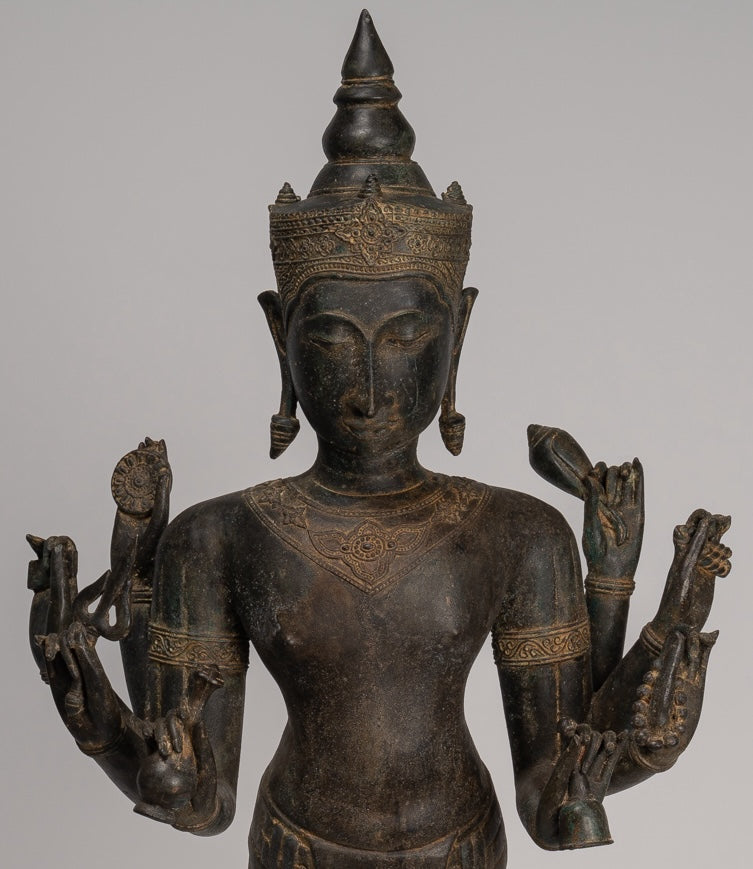
Vishnu's Divine Implements: Symbolism in the Eight Arms
Introduction
In Hinduism, Lord Vishnu, one of the principal deities in the Trimurti, is often depicted with multiple arms, each holding significant objects and symbols. These eight arms carry various attributes that symbolize Vishnu's divine powers, cosmic functions, and his role as the preserver of the universe.
This Blog explores the symbolism embedded in the objects held by Vishnu in his eight arms, shedding light on the rich mythological and spiritual significance attributed to each.
-
Conch Shell (Shankha): One of the primary attributes of Vishnu is the conch shell, known as Shankha. Symbolizing the divine sound of creation, the conch is blown at the beginning of auspicious ceremonies and is associated with the sacred cosmic sound, "Om." Its presence signifies the origin and continual creation of the universe.
-
Discus (Chakra): Vishnu holds the discus, known as Chakra. This razor-sharp disc represents the wheel of time and the cyclic nature of the cosmos. It is a symbol of Vishnu's omnipresence and his ability to control and govern the cosmic order.
-
Mace (Gada): The mace, or Gada signifies the elemental force and strength required for the preservation and protection of dharma (righteousness). The mace represents the power to defeat ignorance and uphold justice.
-
Lotus Flower (Padma): The lotus is a symbol of purity, enlightenment, and divine beauty. Its presence represents the emergence of spiritual consciousness from the waters of material existence, highlighting Vishnu's transcendental nature.
-
Bow (Sarnga): This bow symbolizes the power to direct energy and determine the course of events. It represents Vishnu's role in maintaining cosmic order and ensuring the balance of creation.
-
Arrow (Shaft): The arrow is an essential companion to the bow. It symbolizes precision, focus, and the directed force of righteous action. Vishnu's arrow is a tool for dispelling ignorance and overcoming obstacles.
-
Noose (Pasha): This represents the binding force of attachment and desire. Vishnu, through the noose, symbolizes his power to liberate devotees from the entanglements of material existence.
-
Sword (Nandaka): The sword, Nandaka, symbolizes the power of knowledge and discernment. It represents the ability to cut through illusion and ignorance, ensuring the triumph of wisdom over delusion.
Symbolic Unity
The objects held by Vishnu in his eight arms collectively embody the principles of cosmic order, righteousness, and spiritual enlightenment. Each attribute serves as a symbolic representation of his multifaceted divine powers and cosmic responsibilities. Together, these implements create a visual narrative of Vishnu's role as the preserver and protector of the universe, ensuring the continuity of dharma and the eternal cycle of creation, preservation, and dissolution.
Conclusion
The symbolism embedded in Vishnu's eight arms and the divine implements he holds offer profound insights into the complexities of Hindu cosmology and philosophy. Each attribute carries a unique significance, contributing to the overarching narrative of Vishnu's divine role as the preserver and sustainer of the cosmos.
As worshippers contemplate these symbols, they are reminded of the eternal principles of righteousness, knowledge, and spiritual evolution, guiding them on the path of dharma and divine understanding.












